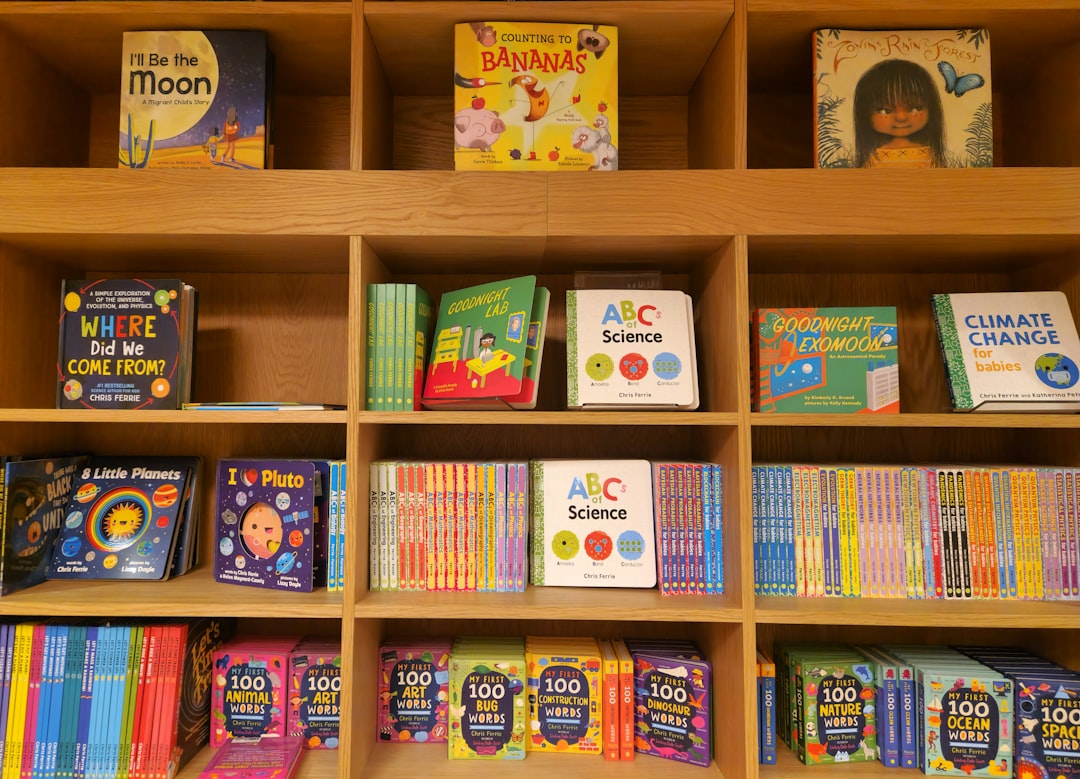

Engage prospects with a scan and streamline customer engagement with FREE QR code marketing tools by Sona – no strings attached!
Create a Free QR CodeFree consultation

No commitment

Engage prospects with a scan and streamline customer engagement with FREE QR code marketing tools by Sona – no strings attached!
Create a Free QR CodeFree consultation

No commitment
Children’s book publishers are experiencing a digital transformation, blending traditional print with emerging technologies to meet the evolving expectations of readers, parents, and educators. Engaging audiences offline and driving them to online experiences is now a strategic priority. However, many publishers struggle to bridge these worlds, relying on static marketing materials or manual data collection that often miss high-value prospects, leaving rich engagement signals untracked and losing opportunities to nurture readers from initial interest through to purchase or advocacy.
QR codes are now essential tools for children’s book publishers, offering interactive touchpoints that convert fleeting interest at book fairs, classrooms, and retail shelves into measurable digital actions. By providing instant access to bonus content, educator resources, or direct buy links, QR codes in marketing close the visibility gap that arises when offline interest is lost in traditional campaigns. Publishers can collect first-party data at the point of engagement and quickly respond to genuine audience intent, even if the initial interaction was anonymous or casual.
As publishers seek scalable ways to delight readers, capture valuable signals, and inform future releases, QR code technology emerges as a creative lever for both operational efficiency and strategic growth. This guide explores how children’s book publishers can overcome roadblocks, such as disconnected messaging, missed leads, and inconsistent tracking, by implementing QR code-driven workflows that are measurable, privacy-conscious, and built for real-world engagement.

Children’s book publishers have long relied on printed flyers, contest forms, and in-person events to reach young readers and key influencers. However, these analog tactics frequently leave high-value prospects untracked, meaning strong purchase intent or interest is rarely captured in the CRM, impeding targeted follow-up and remarketing. Integrating QR codes into these moments transforms passive touchpoints into active conversion opportunities and introduces a scalable way to identify intent on the spot.
The key is to design QR moments that mirror your funnel: discovery, consideration, and conversion. Each scan should have a clear purpose, a relevant destination, and measurable outcomes. With dynamic QR codes and a platform like Sona QR, you can connect scans to CRM records, update destinations after printing, and attribute revenue to offline interactions. The result is a closed-loop system that captures demand where it occurs and moves families, educators, and librarians toward timely next steps.
Advanced platforms now help manage this process from dynamic code generation and attribution to real-time tracking, reducing manual work while ensuring no potential champion, educator, or family slips through unnoticed.

Many children’s book publishers find themselves frustrated as high-energy offline engagement fails to generate meaningful, trackable results. After a busy book fair or classroom event, core challenges remain: anonymous traffic leaves without a trace, and there is no practical way to distinguish casual browsers from truly interested buyers. QR codes address these pain points by turning every touchpoint, such as a book cover, event booth, or handout, into a measurable entry point with an immediate digital next action.
QR technology bridges the offline to online gap, providing visibility into who interacts and what drives their curiosity. Publishers gain the ability to update campaigns even post-print with dynamic QR codes, and with granular analytics they can determine which content or placements inspire action. This eliminates wasted marketing spend on unqualified audiences and ensures high-intent prospects receive consistent follow-up no matter where they first encounter a book or brand.

Certain formats are particularly effective for children’s book publishers because they reflect real-world scenarios in which families, educators, and librarians engage. When a parent stands in a bookstore or a teacher reviews a classroom kit, the destination must feel useful and immediate. Dynamic QR codes also solve the problem of static campaigns becoming outdated, letting publishers adjust digital destinations whenever audience interests shift or new milestones occur.
Choose formats based on the action you want to encourage. If you want to capture intent, use form-based codes. If you want to delight and inform, use web links leading to trailers, read-alouds, or interactive activities. For author bookings and school visits, vCards streamline contact management and reduce friction for busy educators.
Modern QR platforms like Sona QR streamline the creation and management of these formats, enabling granular tagging, centralized management, and real-time edits while ensuring every engagement is purposeful, tracked, and easy to adjust.

Physical engagement remains central for children’s book publishers, yet manual follow-up and missed buying signals frequently erode ROI. QR deployment delivers the most value when placed where attention is high and actions are clear. Focus on high-visibility placements that reach families, educators, and librarians where they browse, buy, and teach, then pair each placement with a compelling call to action.
Map your audience journeys across environments such as homes, classrooms, libraries, and festivals. Use QR codes to bridge those spaces, turning each interaction into a measurable step forward. By diagramming engagement points as a connected system, publishers can eliminate fragmented messaging and make sure each scan adds value across the entire buyer journey.
Tangible use cases show how QR codes solve recurring pain points, from lost leads to dormant engagement. By pairing each code with a clear benefit and measurable outcome, publishers not only engage audiences but also collect the insight required to refine future launches, reprints, and outreach.
The most successful deployments give readers and educators something valuable in exchange for a scan. Consider whether you are encouraging a quick delight, such as an author read-aloud, or a deeper action, like joining a newsletter or requesting a school visit. Every use case becomes a data point that improves segmentation and retargeting.
Segmenting audiences on assumptions or broad demographics leads to wasted spend and inconsistent messaging. High-value prospects such as librarians, educators, and engaged parents are easily overlooked when their signals are not captured. QR code tracking creates behavior-based segments that reflect real interest and context, improving conversion across channels.
Design your QR system to capture who scanned, where it happened, what they wanted, and what they did next. With Sona QR, tags can be applied automatically for campaign, placement, and audience type. This enables automated nurture flows that move people from interest to purchase and then to advocacy.
Disjointed campaigns can confuse prospects and drain budgets, especially when print and digital efforts are misaligned. When embedded thoughtfully, QR codes connect these channels into a seamless journey that respects how families and educators actually discover and evaluate books. Each scan becomes a signal that informs creative strategy and budget allocation.
A connected mix ensures that scans collected on book covers, at events, in mailers, and across social content feed into a single attribution view. With Sona QR, you can manage all codes centrally, update destinations in real time, and monitor performance by channel and creative. Use QR to bridge offline to online across your content and campaigns.
A well-structured execution plan helps children’s book publishers move quickly from idea to impact while avoiding preventable gaps. Use this checklist to ensure each campaign has a clear goal, a strong creative approach, and a measurable path to conversion.
Start small, validate assumptions, and scale based on data. With dynamic QR codes and a platform like Sona QR, you can iterate in real time, update destinations post-print, and turn every scan into a signal that improves your next decision.
One of the largest pain points for children’s book publishers is the inability to connect offline engagement, such as reading sessions or festival visits, with revenue-driving outcomes. QR-driven tracking and attribution features address this by linking each scan to channel, placement, and follow-on behavior. The outcome is a performance view that justifies investment and guides creative refinement.
Knowing someone scanned a code is useful, but without understanding how that engagement influenced the buyer journey, you are flying blind. Sona QR and Sona close this gap by turning disparate interactions into a unified journey with identity resolution, multi-touch attribution, and CRM enrichment.
Scaling what works requires a blend of creative discipline and operational rigor. Focus on consistency in design, clarity in value propositions, and reliability in tracking. Keep optimizing creative and destinations to improve conversion rates as you expand across titles and series.
Adapt your approach to the realities of each environment. A code that performs on a bright festival banner might need a different treatment on a matte catalog page. Small design tweaks, stronger CTAs, and dynamic destinations often produce large gains in scan rates and conversions.

Industry peers are already closing the gap between offline excitement and measurable outcomes by deploying QR codes in creative ways. The following examples illustrate how small changes in placement and offer design can produce meaningful lifts in engagement and sales while feeding better data back into marketing systems.
Publishers that pair QR codes with genuine value, such as free activities, guided readings, or educator bundles, see higher scan-to-conversion rates. They also collect richer first-party data that informs future releases, cover designs, and event strategies.
Expert deployment is not only about generating scans. It is about creating satisfying micro-experiences that nudge readers and educators forward while ensuring everything is measurable and improvable. Lean on strong creative framing, clear benefits, and consistent tagging so each scan becomes a reliable signal.
Avoid pitfalls that quietly erode performance. Poor placement, low contrast, or generic landing pages can suppress scan rates or waste intent. Take the extra step to match context, audience, and offer so the value of scanning is obvious at a glance.
QR codes have evolved into a mission-critical asset for children’s book publishers working to capture and nurture demand at every stage. By intuitively linking print and event experiences to personalized digital journeys, and by surfacing engagement signals that so often go untracked, publishers can finally close the loop between offline interest and online conversion. Adopting a well-integrated QR strategy not only reduces wasted spend and disconnected messaging, but also unlocks new levels of measurable insight, increased sales, and delighted readers.
Placing QR technology at the heart of your marketing and attribution efforts positions your team to outpace competitors, adapt quickly to changing market needs, and foster lasting connections with your most valuable audiences. Start with a single high-impact use case, measure rigorously, and expand what works. With Sona QR for code management and Sona for attribution, you can generate your first codes in minutes, update them as campaigns evolve, and connect every scan to outcomes that matter. Start creating QR codes for free.
QR codes have transformed children’s book publishers from static storytelling into interactive, measurable engagement channels. Whether it’s driving new reader acquisition, enriching the reading experience with multimedia content, or fostering deeper connections between authors and young audiences, QR codes turn every page into a gateway for meaningful interaction and valuable data collection. Imagine knowing exactly which book features spark the most interest—and being able to update content instantly to keep readers coming back for more.
With Sona QR, you can create dynamic, trackable QR codes in seconds, effortlessly update campaigns without costly reprints, and link every scan directly to sales and engagement metrics. No more guessing which marketing efforts resonate—just smarter strategies that grow your readership and revenue.
Start for free with Sona QR today and transform every scan into a lasting connection and a powerful conversion.
Children’s book publishers can use QR codes to connect offline touchpoints like book fairs, classrooms, and retail displays to online content such as bonus materials, educator resources, and purchase links, enabling measurable engagement and targeted follow-up.
QR codes turn passive offline interactions into active, trackable digital actions by linking scans to CRM records, enabling real-time follow-up, updating destinations dynamically, and attributing revenue to offline engagement.
Common formats include web links for sample chapters and trailers, forms for contest entries and resource requests, vCards for author bookings, app downloads for companion apps, and dynamic content codes that can be updated after printing.
High-visibility locations such as book covers, event signage, direct mail inserts, classroom kits, and library or retail displays are ideal for QR codes to capture audience interest and drive measurable actions.
By creating journey-specific QR codes tagged by audience segment, location, and campaign, publishers can capture behavior-based data that syncs with CRMs and ad platforms to automate personalized nurture flows and improve conversion.
The steps include defining the missed opportunity and campaign goal, selecting appropriate QR code types, designing and testing codes with clear CTAs, deploying across impactful channels, and tracking and optimizing performance through data.
Publishers track scans by time, location, and campaign source; measure engagement outcomes like email sign-ups and sales; update dynamic QR destinations in real time; and sync data with CRMs for attribution and revenue connection.
Experts recommend using prominent codes with benefit-led CTAs, tailoring landing pages by audience, training staff to encourage scanning, ensuring accessibility with clear contrast and alt text, and assigning unique codes per asset for accurate attribution.
QR codes provide granular analytics that identify which content and placements inspire action, allowing publishers to focus budget on qualified audiences and automate follow-up to convert high-intent prospects.
QR codes create seamless offline-to-online continuity by enabling immediate access to digital content from physical materials, capturing audience intent at the moment of interest, and allowing flexible updates without reprinting.
Use Sona QR's trackable codes to improve customer acquisition and engagement today.
Create Your FREE Trackable QR Code in SecondsJoin results-focused teams combining Sona Platform automation with advanced Google Ads strategies to scale lead generation

Connect your existing CRM

Free Account Enrichment

No setup fees
No commitment required

Free consultation

Get a custom Google Ads roadmap for your business






Launch campaigns that generate qualified leads in 30 days or less.
